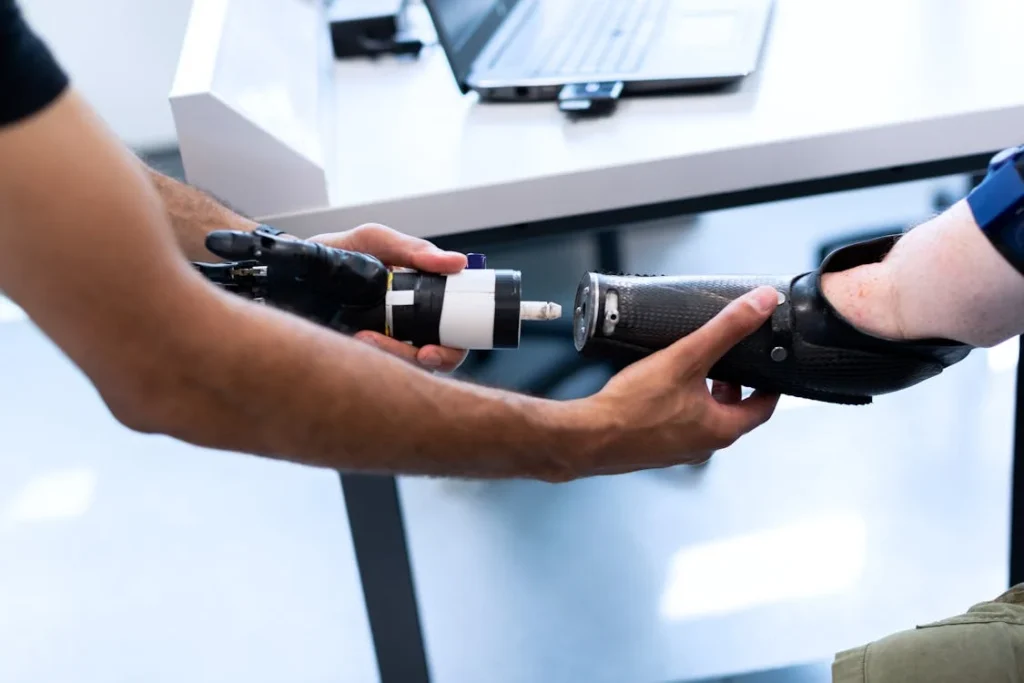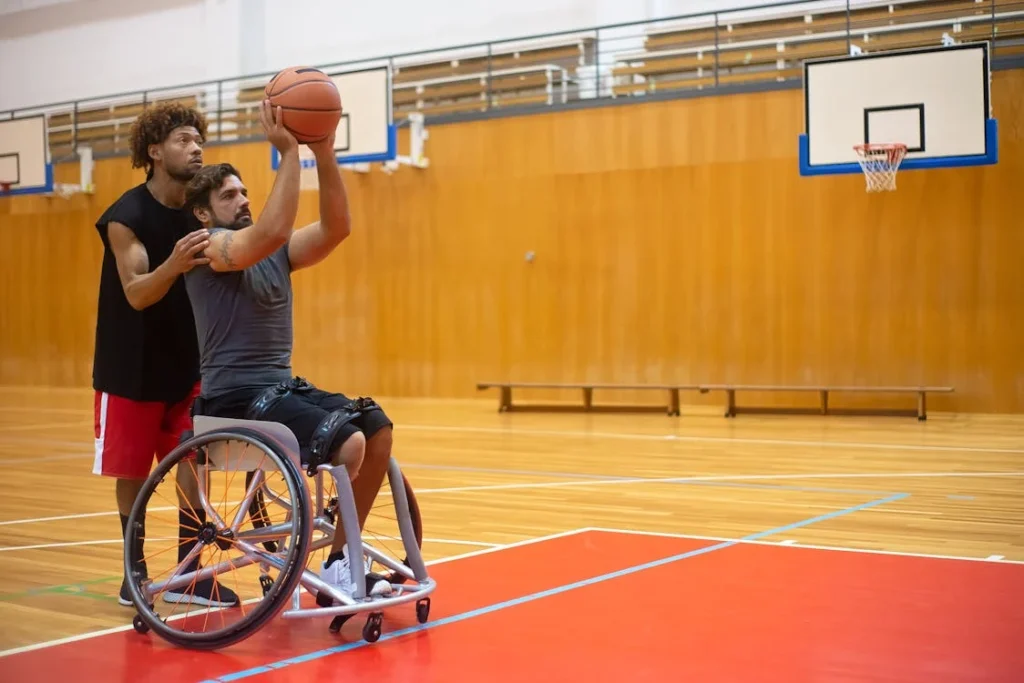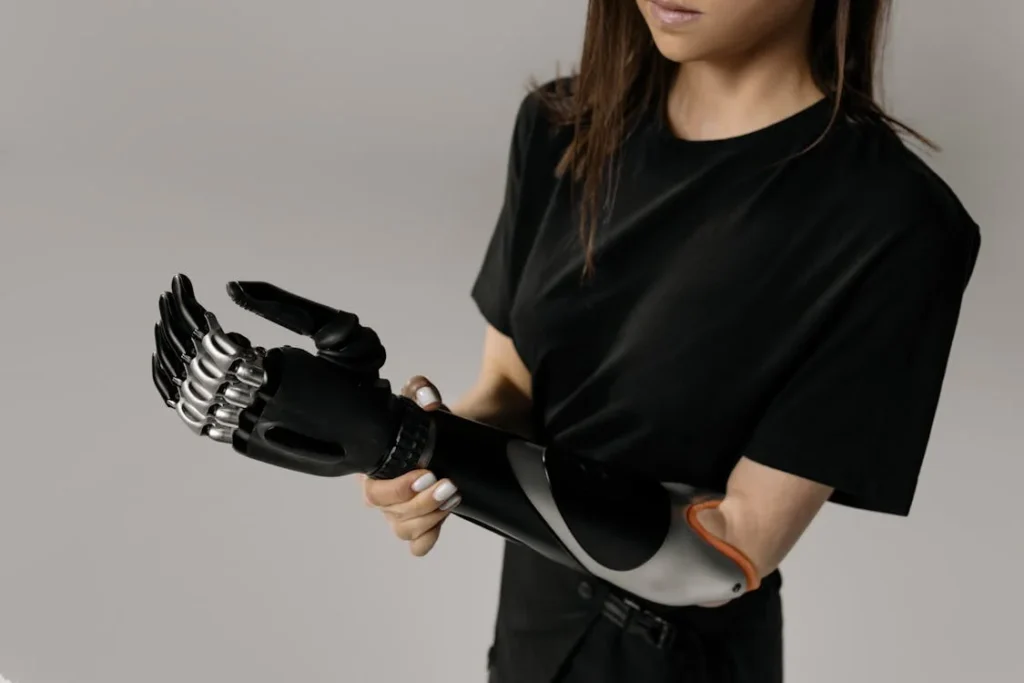There are moments in life that change everything. One of those moments happens when you or someone you love is told they may lose a limb. It can be due to a serious injury, cancer, infection, or a condition that stops blood from flowing properly. Whatever the reason, the choices ahead are tough. One of the biggest is deciding between limb salvage surgery and amputation.
Both options aim to help you move better, live well, and avoid future problems. But they take you down very different paths. One tries to save the limb, even if it needs multiple surgeries and months of recovery. The other removes the limb and replaces it with a prosthetic, which may offer a quicker and sometimes more stable outcome.

What Is Limb Salvage Surgery?
A Closer Look at the Process
Limb salvage surgery is a medical approach where doctors work to save and reconstruct a damaged arm or leg instead of removing it.
This usually happens when the limb has been affected by a serious injury, cancer, or an infection, but still has a chance to function if treated carefully. The idea is not just to keep the limb, but to help it work well enough to support your daily life.
These surgeries can be complex. Doctors may remove diseased or dead bone, clean out infections, or replace parts of the limb with metal implants or bone from other parts of the body.
Sometimes, soft tissue or skin is also moved from other areas to cover the wound and help with healing. In cases where cancer is involved, doctors also remove the tumor while trying to protect the healthy parts of the limb.
This kind of surgery often involves a team—orthopedic surgeons, plastic surgeons, infection specialists, and physical therapists. They work together not just to perform the operation but to support the healing process afterward.
It’s important to understand that limb salvage is rarely a single-step solution. It may take multiple surgeries over time to rebuild the limb and manage complications that can arise along the way.
The Recovery Journey
Recovering from limb salvage takes time and effort. It isn’t something that happens overnight. After surgery, you’ll likely spend time in the hospital for close observation.
Doctors monitor the healing of wounds, the success of any grafts or implants, and watch for signs of infection or rejection.
Once you’re stable, the next phase is physical therapy. This helps you regain strength, movement, and balance. If the leg was operated on, learning to walk again can take weeks or even months. If it was an arm, the focus might be on gripping, lifting, or improving hand coordination.
During this time, setbacks are possible. Some people experience pain that doesn’t go away easily. Others might face stiffness in joints, muscle weakness, or poor healing in the bone or soft tissue.
These are common and often expected parts of the journey, but they can be emotionally tiring and physically frustrating.
Still, for many, the reward is worth it. Keeping your natural limb can help with balance, sensation, and emotional comfort. Even if it doesn’t return to full strength, having your own limb can make everyday tasks feel more familiar.
However, this decision also comes with risks. Not every limb that goes through salvage surgery ends up functioning well. In some cases, people live with chronic pain, ongoing mobility issues, or the possibility of another major surgery if things don’t improve.
That’s why doctors must look at the whole picture—your age, health, the type of injury, and how well your body is expected to heal.
They must also consider what matters most to you: Is it keeping the limb no matter what? Or is it being able to move with freedom and less pain, even if that means living with a prosthetic?
When Is Limb Salvage Usually Considered?
Doctors typically suggest limb salvage when they believe the limb has enough healthy tissue and blood flow to heal after surgery. If nerves and muscles are still working and the bone can be rebuilt or supported, there may be a good chance for success.
It is also more commonly chosen when the person is younger, active, or has a lifestyle where keeping the limb would offer better long-term outcomes. Children and young adults often adapt more easily, and their bodies heal faster.
In cancer cases, limb salvage is often offered if the tumor can be removed without affecting the rest of the limb too much. Modern treatments and tools have made this more possible than ever before, especially with the help of 3D imaging and custom-designed implants.
However, limb salvage isn’t always an option. If there is too much damage to the blood vessels or nerves, or if there’s a serious infection that won’t go away, the risks of keeping the limb might be higher than the benefits.
In those cases, amputation may be the safer, more predictable path.
One thing to remember is that choosing limb salvage doesn’t lock you in forever. If the surgery doesn’t succeed or causes more problems, amputation is still possible later.
But going through both can be physically and emotionally exhausting, so it’s important to have clear, honest conversations with your doctors from the beginning.
What to Think About Before Choosing Limb Salvage
Before you make any decision, it’s helpful to think beyond just the surgery. Ask yourself what kind of life you want in the months and years ahead. Do you have support at home? Are you prepared for a long recovery process? Can you take time off work or school for treatment and rehab? Are you okay with the possibility of more surgeries later?
Also, think about how you feel about your body. Some people are very emotionally attached to their limbs and feel strongly about keeping them.
Others are more focused on function and mobility, no matter what that looks like. There’s no right or wrong way to feel—what matters is what makes you feel like yourself.
Doctors can guide you through the medical part, but the decision goes beyond the hospital. It’s about your daily life, your goals, and what will help you live as fully and freely as possible.

Understanding Amputation: A Different Path to Healing
What Amputation Really Means
Amputation is the surgical removal of a part of the body, most often a leg or arm, when it cannot be saved. This might sound like a drastic step, but in many cases, it offers a cleaner and more reliable path to recovery.
It’s usually considered when the damage is too severe, the risk of infection is too high, or when previous surgeries have failed to restore proper function.
The idea behind amputation is to remove the part of the limb that is no longer helping the body and replace its function with a prosthetic.
While the thought of losing a limb is overwhelming, many people who go through amputation find a surprising sense of relief afterward. Pain decreases. Infection risks drop. Life becomes more stable and manageable again.
In medical terms, amputation is often more straightforward than limb salvage. The procedure is usually done in one major surgery, followed by a focused recovery process.
Of course, that doesn’t make it easy. Emotionally, it can be one of the hardest decisions a person makes. But it can also lead to quicker healing, faster return to work, and more consistent movement—especially when paired with modern prosthetic solutions.
What Recovery After Amputation Looks Like
Recovery after amputation happens in phases. The first step is healing from the surgery itself. This means managing the wound, building strength, and making sure the body adjusts well to the change.
Once the area has healed, the next phase begins—preparing for a prosthetic limb.
This part takes time and guidance. Before a prosthetic can be fitted, the limb has to reach a stable shape. Swelling has to reduce, and the skin must toughen up to handle pressure.
Physical therapy starts early to keep the rest of the body strong and teach balance, posture, and movement.
Learning to walk or use a prosthetic arm feels unfamiliar at first. It takes patience, support, and a good rehab plan. Some people start slow, with simple tasks like standing or holding objects. Over time, the movements become more natural, especially as confidence grows.
Pain management is also part of recovery. Some people feel phantom limb pain—a sensation where the missing part feels like it’s still there.
This is common and manageable with therapy, medication, and time. Emotional healing is equally important. Many people feel grief, sadness, or anger after losing a limb. These feelings are normal and should be talked about, not buried.
The good news is that with the right support, most amputees regain independence, strength, and a clear path forward. In fact, many return to work, sports, and travel much sooner than expected. The recovery is not easy, but it is highly possible.
How Amputation and Prosthetics Work Together
Today’s prosthetic limbs are more advanced than ever before. Legs can bend and respond to walking speed. Arms can grip objects with real strength and even allow fine motor skills.
Some prosthetics have smart sensors that adjust to terrain, helping users walk with ease across stairs, slopes, and uneven ground.
The success of a prosthetic depends on fit, training, and consistency. A prosthetic that fits well and feels natural makes a huge difference.
That’s why the fitting process involves several stages—testing, adjusting, and checking comfort over time. When the fit is right and rehab is followed carefully, the prosthetic can feel like a true part of the body.
Unlike limb salvage, which relies on the body healing itself, amputation and prosthetics rely on external support and technology.
That means progress can be faster and more predictable, but it also requires maintenance and regular follow-ups. Prosthetics wear down over time. The body changes. Regular check-ins ensure that the device keeps up with the person’s needs.
There’s also freedom in using a prosthetic. Many people find they can move more confidently than they ever could with a weak or painful salvaged limb. With time, many even forget they’re using a device—it becomes part of how they live.
Comparing Amputation to Limb Salvage in Real Life
While limb salvage keeps the natural limb, it doesn’t always restore full function. The limb might still be weak, painful, or hard to use. Amputation removes the limb but replaces its function in a different way. Which is better? That depends entirely on the individual.
In many studies, people who chose amputation reported higher satisfaction over time, especially when their prosthetics worked well and they had strong rehab support. They walked farther, moved more easily, and went back to work faster.
However, limb salvage patients often said they felt emotionally better in the beginning because they kept their limb. But that feeling sometimes faded if pain, stiffness, or limited mobility became long-term problems.
One of the biggest differences is how stable the outcome feels. Amputation offers a more consistent path forward—once healing is done and the prosthetic fits, daily life becomes more manageable.
Limb salvage can be unpredictable. One day might feel good, and the next could bring pain, swelling, or a need for more treatment.
Emotionally, both paths require strength. There’s no “easier” route. But knowing what to expect helps reduce fear and confusion. What matters most is choosing the path that leads to a full, mobile life—not just today, but for years to come.

What to Consider Before Making Your Decision
Your Body, Your Healing Capacity
The condition of your body is one of the first things to look at when deciding between limb salvage and amputation. Age plays a role, but it’s not the only factor.
What matters most is how well your body heals. If your bones are strong, your circulation is healthy, and your skin recovers well from injury, then limb salvage may have a higher chance of success.
On the other hand, if healing has been slow in the past or if there are other medical issues—like diabetes or poor blood flow—amputation may offer a safer and more stable solution.
Doctors will often run scans, blood tests, and detailed physical exams to check how well your body can handle one path or the other.
This isn’t just about the initial recovery—it’s about whether your body can support you in the months and years that follow. A limb that takes years to heal or continues to get infected may not serve you well, even if it looks normal on the outside.
Pain Tolerance and Future Comfort
Pain is a major part of the decision. Not everyone experiences pain the same way, and how much you’re willing to deal with can influence which option is right for you.
Limb salvage can come with lingering pain—nerve pain, joint pain, or discomfort from implants. Some people live with this pain for years, even after successful surgery.
Amputation comes with its own pain challenges, like phantom limb sensations or soreness from the prosthetic. But many people report that these issues are easier to manage than the constant pain of a non-functioning salvaged limb.
It’s also worth thinking about long-term comfort. Will you be able to sleep? Sit for long periods? Walk without struggling? Comfort adds up, especially over years of daily life.
Time and Lifestyle
Time matters. If you’re someone who needs to return to work quickly or has responsibilities that can’t be put on hold for long, the length of recovery can be a deciding factor.
Limb salvage often means a longer hospital stay, more surgeries, and extended rehab. For some, that time commitment isn’t realistic.
Amputation, although emotionally harder at first, can sometimes offer a clearer timeline. Once the wound heals and the prosthetic is fitted, many people return to their routines faster.
This is especially important if you have a family to care for, a business to run, or physical goals you want to reach.
Lifestyle also plays a huge part. If you enjoy hiking, biking, or being active, you might find that a prosthetic gives you more freedom than a stiff or painful salvaged limb.
On the other hand, if your activities are mostly stationary or involve light walking, you might do just fine with a saved limb—even if it isn’t perfect.
Financial and Logistical Considerations
Cost is something no one likes to think about, but it’s important. Limb salvage can be expensive, especially if you need multiple surgeries or hospital stays.
The cost can stretch over months or years. And even after surgery, there may be a need for custom shoes, braces, or home adaptations.
Amputation also comes with expenses. High-quality prosthetics can be costly, and they need to be replaced or repaired over time.
But once the device is fitted and working well, many of the other costs become more predictable. There’s also less need for ongoing surgery or hospital visits, which can reduce financial stress in the long run.
Access to care matters too. Are you near a hospital that offers limb salvage surgery? Do you have access to physical therapy, prosthetic fitting centers, or rehab clinics? These services aren’t available everywhere, and if they aren’t close by, the effort it takes to reach them can affect your recovery.
Emotional Readiness
This decision isn’t just physical—it’s deeply emotional. Some people feel devastated at the thought of losing a limb. They can’t imagine themselves without it.
Others might feel scared of constant surgeries, pain, or the idea that they’re holding onto something that won’t work well again.
Both paths require mental strength. Limb salvage often asks for patience through long periods of healing, setbacks, and uncertainty. Amputation requires acceptance of change, and the courage to adapt to a new way of moving through the world.
It helps to talk about it. Speak with your doctors. Ask if you can meet someone who’s been through each option. Hearing personal stories—good and bad—can open your eyes to things you might not have considered.
What Does Independence Look Like to You?
At the heart of this decision is one big question: What kind of life do you want to lead?
Some people value the emotional comfort of keeping their limb, even if it isn’t perfect. They’re okay with a slower walk, a brace, or occasional pain if it means staying whole.
Others want the ability to move freely, play with their kids, travel, or walk without help—even if that means using a prosthetic.
There is no wrong answer. What matters is how you define freedom, comfort, and quality of life. No one else can make that call for you.

Preparing for the Road Ahead: What to Expect After Your Decision
Getting Ready for Limb Salvage
Once you and your medical team choose limb salvage, preparation becomes just as important as the surgery itself. This isn’t a one-time event.
It’s a longer journey that will likely include more than one procedure, several months of healing, and regular physical therapy. That’s why setting the right expectations from the start is key.
Before surgery, your doctors will explain exactly what will be done. They may use scans or imaging to show how they plan to remove damaged tissue or bone and what kind of implants or grafts might be used.
Knowing this in advance can help you feel more in control and less anxious.
You’ll need to prepare your home, too. If your leg is involved, think about mobility.
Can you get around with crutches or a walker? Do you have support for things like getting out of bed, using the bathroom, or climbing stairs? These changes are temporary, but planning ahead helps avoid frustration later.
Emotionally, this is a time to gather your support system. Let your friends and family know what’s ahead. You’ll need their help—not just with meals and errands, but with motivation when the days feel long or progress seems slow.
After the surgery, you’ll probably spend time in the hospital before moving into a rehabilitation phase. Physical therapy will begin as soon as your doctors feel it’s safe.
This therapy isn’t just exercise—it’s your way back to movement. You’ll practice standing, balancing, walking, and building strength in the muscles that support your limb. Some days will be hard. Progress may feel slow. But if you stay committed, every small gain adds up.
Be prepared for follow-ups. Your surgical team may need to make adjustments, monitor healing, or address setbacks. There may be days when you feel like you’re moving backward. That’s normal. Limb salvage is a winding road, not a straight one.
Preparing for Amputation
If you and your care team decide on amputation, the first step is preparing your mind and body for change.
Unlike salvage, which focuses on saving the existing limb, amputation is about transitioning to a new way of living—with a prosthetic, new routines, and a body that feels different than it did before.
The days leading up to surgery can be emotional. You may feel fear, sadness, or even relief if you’ve been in pain for a long time.
These feelings don’t have to be fixed—they just need to be heard. Talking with a counselor, peer support group, or someone who’s been through it can make a big difference.
Physically, your doctors will check your overall health to ensure you’re ready for surgery. They’ll also talk about where the amputation will occur, and what level is best for prosthetic use.
Every decision is about balance—removing what must go, but leaving as much healthy bone and muscle as possible for future strength.
After surgery, you’ll begin recovery in stages. First is wound healing. Your body needs time to adjust. The area may swell or feel sore, and you might feel phantom sensations—your brain still believes the limb is there. These feelings often fade with time, therapy, and certain treatments.
As you heal, your rehab team will introduce exercises to strengthen your body and prepare you for prosthetic training. You’ll learn to shift weight, balance, and move in new ways. These early steps are vital—they build the foundation for every movement you’ll make with your prosthetic later on.
At some point, you’ll be ready for your first fitting. This part is exciting, but it also takes patience. The prosthetic won’t feel perfect right away.
Your residual limb may change shape over time, and the device may need adjustments. That’s normal. The goal isn’t just to wear the device—it’s to use it as a natural part of your body.
Alongside the physical changes, you’ll also rebuild your confidence. You’ll learn how to walk into a room, talk about your experience, and take part in life without holding back. This takes courage, and it happens one day at a time.
What Both Paths Have in Common
Whether you choose limb salvage or amputation, one thing is certain: you’ll need time, support, and commitment to recover fully. Neither path is easy, and neither is better for everyone. But both can lead to a strong, independent life if you’re prepared.
Both paths will test your patience. You’ll have good days and hard days. You’ll need to stay in touch with your medical team, show up for therapy, and speak up if something doesn’t feel right.
You’ll also learn a lot about your own resilience—how strong you are, how flexible you can be, and how much you’re capable of overcoming.
In both cases, the people around you matter. A supportive friend, a kind therapist, a skilled doctor—these are the people who walk beside you. Recovery is easier when you don’t feel alone.
And most importantly, both paths are about progress, not perfection. You may not move exactly as you did before. You may take longer to get there. But with the right mindset and the right support, you can get back to living fully.

Learning from Others: What Real People Say About Their Choice
Stories Behind the Decisions
When facing a choice between limb salvage and amputation, nothing hits closer to home than hearing from people who have already made the decision. Their journeys are rarely easy.
But their experiences often shed light on things you might not find in medical brochures or even in your doctor’s office. Every story is different, but each one helps make the unknown feel a little more familiar.
Some people go through traumatic accidents—road crashes, industrial injuries, or natural disasters. Others are diagnosed with bone cancer, severe infections, or diabetic complications that affect blood flow.
Regardless of the cause, they all reach a point where a life-changing decision must be made: try to save the limb or remove it and start over.
One man who suffered a crush injury to his lower leg chose limb salvage. At first, he was relieved to keep his leg. The doctors rebuilt the bone using metal rods, and skin from his thigh was grafted over the wound.
But after a year and four surgeries, he still couldn’t walk without pain. He eventually asked for an amputation, saying he felt trapped in a cycle of operations and recovery with no clear end in sight.
After the amputation, he said he finally felt free. With a well-fitted prosthetic and steady rehab, he was back at work within months.
Another patient, a young woman with bone cancer in her femur, chose limb salvage. Her doctors replaced part of her leg bone with a custom metal implant.
The first few months were difficult—constant physical therapy, limitations in movement—but with time and persistence, she regained mobility.
Years later, she still walks with a slight limp, but says she’s glad she kept her leg. For her, the emotional value of keeping her limb outweighed the slower progress.
What stands out in these stories is not whether they chose limb salvage or amputation—it’s that they made the decision based on their own values, lifestyle, and what they were willing to face.
And they didn’t make it alone. They spoke with specialists, met other patients, leaned on family, and took time to understand what recovery would really look like.
Emotional Insights That Don’t Show Up in Charts
What people don’t often say out loud—but feel deeply—is how this decision affects their identity. It’s more than a medical problem. It becomes personal. It touches how you see yourself, how you want to be seen by others, and how you define a full life.
Those who chose amputation often describe a strange kind of clarity after surgery. The anxiety of “will this limb ever work again?” goes away. There’s no more guessing.
The path forward is direct, and many find strength in that. One woman shared that she never thought she could feel confident wearing a prosthetic, but over time, she started running 5Ks and even wore shorts in public.
She said the freedom to move without pain mattered more than what others saw.
People who chose limb salvage talk about a sense of comfort in keeping what’s theirs. Even if the function isn’t perfect, they find peace in knowing they tried.
They often describe the limb as “mine,” with a connection that’s hard to put into words. Still, some admit that the long healing process tested their patience more than they expected.
Several said that if things hadn’t improved within a year or two, they would have seriously considered switching to amputation.
These are emotional truths that aren’t part of any medical chart. But they’re real. And they matter just as much as infection rates, healing timelines, or rehab schedules.
What Most of Them Would Tell You
After listening to enough stories, one message comes through again and again: Take your time. Ask questions. Don’t rush the choice.
People who felt satisfied with their decision—no matter which one they chose—almost always said they felt informed.
They understood the risks, the benefits, and the real-life trade-offs. They didn’t go in expecting perfection. They prepared themselves mentally for the journey, not just the outcome.
Many also say to think long-term. What feels good in the short run might not work for your future. A limb that looks healthy but doesn’t move well might limit your independence. A prosthetic that gives you motion but requires emotional adjustment might be worth it in the end.
And perhaps most importantly, many people say this: You’re not alone. There are others who’ve walked this road before you. Find them. Listen to them.
Whether it’s through support groups, online forums, or rehab centers, connecting with others who understand can give you the insight and courage to move forward.

The Mental Side of Recovery: Why Mindset Shapes Mobility
Healing Begins in the Mind
When it comes to medical recovery, most people think of surgeries, wounds, rehab exercises, and physical strength. But there’s another side that carries just as much weight—the emotional and psychological part.
The truth is, your mindset can affect your progress more than you might expect. It influences how you handle pain, how committed you are to rehab, and how confident you feel while moving through daily life after either limb salvage or amputation.
After such a major life event, it’s completely normal to feel overwhelmed. There’s fear of the unknown, frustration with slow progress, and grief for what was lost or changed. But how you respond to those emotions can determine how steady your recovery will be.
A positive, flexible mindset doesn’t mean pretending things are fine. It means learning to adapt, finding reasons to keep going, and trusting that your body can still carry you forward.
People who maintain a realistic but hopeful attitude tend to recover better—not necessarily faster, but with more consistency. They’re more likely to stick with physical therapy, ask for help when needed, and find creative solutions when obstacles come up.
Emotional Challenges You May Not Expect
Choosing between limb salvage and amputation isn’t just about medical options. It’s also about identity. Your body is how you move through the world—and when it changes, your relationship with it shifts, too.
For some, keeping the limb after salvage surgery feels grounding. It brings comfort. But that same limb might not work the way it used to, which can be frustrating over time.
People may feel trapped in a body that looks familiar but doesn’t perform well. This emotional tug-of-war—between acceptance and limitation—can quietly wear someone down.
With amputation, the emotional challenges are different. There’s a visible change. It’s a permanent loss. But once the initial grief passes, many people describe a mental shift: instead of worrying whether the limb will ever recover, they focus on learning how to live with a new tool—a prosthetic.
That shift can bring relief and even empowerment. Still, there can be days when the mirror feels unfamiliar, or when the stares and questions from strangers create emotional fatigue.
Depression, anxiety, and even post-traumatic stress are not uncommon after either procedure. That’s why having emotional support early on is not just helpful—it’s necessary.
Mental health counseling, peer support, or even simple check-ins with loved ones can reduce isolation and give space to process difficult emotions.
The Power of Small Wins and Support Systems
One of the most powerful things you can do after choosing your path—whether it’s limb salvage or amputation—is to focus on small, meaningful progress.
Recovery doesn’t happen in big leaps. It’s built on the quiet moments: the first time you stand without help, the first step without pain, the first time you tie your shoe, or carry a bag on your own.
Celebrating these moments helps create momentum. It reminds you that you are getting stronger, even if the end goal still feels far away. These small wins build confidence. And confidence leads to action—more therapy sessions, more movement, more life.
But no one should go through this alone. Whether it’s family, friends, a therapist, or a support group, your circle matters. People who feel emotionally supported during recovery tend to do better physically.
They’re more motivated, less likely to give up, and more open to adapting when things don’t go as planned.
Your mindset is like a muscle. It gets stronger the more you use it. And when that mindset is surrounded by encouragement, understanding, and hope, it becomes a powerful tool—just as important as any brace, implant, or prosthetic.
Conclusion
Deciding between limb salvage and amputation is deeply personal. It’s not just about medicine—it’s about your future, your comfort, and your daily life. Both options come with challenges, but both can lead to strength, movement, and independence with the right support.
Limb salvage might offer a sense of wholeness, but it often involves more time, surgeries, and uncertainty. Amputation may feel more final, but it can open the door to reliable mobility, especially with a well-fitted prosthetic and focused rehab.
There’s no one-size-fits-all answer. What matters most is making an informed choice that fits your body, lifestyle, and goals. Take your time, ask the hard questions, and listen to both your doctors and your inner voice.
With the right mindset and support, you can move forward with confidence—no matter which path you choose.



